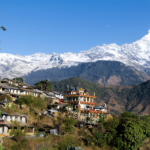Arduous trek to Mount Everest Base Camp in Nepal proves the experience of a lifetime
TREKKING Once over the top bridge, the track became incredibly steep and narrow with rocky, uneven and muddy surfaces. To add to the danger we head vertical drop to our left that reminded us of the value of hugging the hillside, especially when encountering the many yak caravans that passed by. The 700m climb took more than three hours. It was humbling to be overtaken by Sherpas lugging massive loads, some of which were in excess of 100kg.Namche is a delightful village nestled in a horseshoe-shaped valley.Its tea houses and shops open directly on to the paved trails that weave around the valley walls. Our “rest day at Namche included a six-hour trek to the twin villages of Khunde, 3850m, which is famous for the hospital built by Sir Ed Hillary and Khumjong, where a statue of the great man stands guard at the gate of the school he also helped build. After Namche the clouds cleared and for the first time we realized the size of the mountains that dwarfed us from all angles. It also gave us our first view of the iconic peak of Ama Dablam, 6856mand Lhotse, the fourth-highest mountainin the world at 8516m.Each day trek seemed to start with a nasty uphill climb before the famed Nepalese flats became part of its tortuous charm. To put these “Nepal flats undulations into perspective, the altitude difference between our starting point at Lukla and Base Camp was “just 2564m. But we climbed nearly 9000mduring our round trip. As we ascended past 4000m,the thinner oxygen levels almost surreptitiously forced our pace to slow, giving us more time to smell the flowers, take in the magnificent views and stop and chat to the many people we passed. Slowly, slowly had become our mantra.
After Namche, our group had split into two distinct groups, the speedy jack rabbits and the slower “Ray team”, named after one of our group whose trek was cut short by illness. Our tour leader, Prasant, always stayed with the slowest of walkers and his knowledge of the region gave us some valuable insight. By day seven, we had trekked above the tree line and the rhododendron forests. Our visit was in autumn and the forest colors were magnificent hues of red and green.
In spring the flowers are bright red and, according to a Kiwi guide we met, produce a memorable sight. Most of the trekkers are polite, always willing to stop for a chat and follow track etiquette where sherpas, wildlife and climbers ascending have right of way. But there are a few who demand the narrow tracks for themselves: One group literally shoulder-charged one of our group off the track on to glacier rocks. Luckily no one was hurt. There is almost a complete lack of noise apart from the distant roar of the glacial rivers far below. Occasionally there i s the distinctive noise of helicopters ferrying wealthy tourists to Mt Everest for a few snapshots or, less happily, evacuating fellow trekkers who had succumbed to altitude sickness. Now clear of trees, the mountains offered sights in all directions. Traveling around Europe, the joke was (another bloody castle/church). Here it ABM, but they are all worth stopping and taking a snap of. We pass herds of yaks grazing the mountain pastures with their bells chiming in the distance, and little hamlets of well-kept pastures. It is interesting to see locals drying yak dung that is used as heating fuel. World Expeditions only uses yak dung to warm the dining rooms of its permanent camp sites. Any potential smells were always overpowered by the kerosene used to
start the fires.
The difference in temperature snow more noticeable. The clear sunny days are still T-shirt weather, but the morning and afternoon winds have definite bite. Once the sun goes down, it IS cold.
At Dingbat, 4530m, we had our introduction to the oxygen rescue chamber, which rammed home the danger we were about to face. Again, the rest day was anything but, with another shortest but very sleepwalk to help us acclimatise. Day eight was getting to the business end of the trek with a relatively steady climb to overnight in Lobuche,4940m, with the highlight being a ring of memorials to the climbers who died onor around Everest. It was a very moving experience to stop and rest around the many stone cairns. The next day took us Gorak Shep,5164m, and then to Base Camp with theKhumbu Glacial moraine to our right.(From top) Memorial cairns to climbers who died in their bids to conquer theregion peaks, A stone hut in the mountains above Dingboche and Gorak Shep, the last stop before Base Camp.
The path from Gorak Shep was extremely hard going, not only because of the altitude but the glacial rocks we had to clamber over. The views were exceptional, the glaciers unbelievable and the numerous avalanches that thunder down from the surrounding peaks captivating. The final assault to Base Camp was tough, but being able to sit at the rocks beneath the Everest prayer flags was for me a remarkable achievement. That you can barely see the great was irrelevant. It was humbling to be able to reflect on the surrounds that prove such a magnet to the adventurous. The treacherous upper reaches of the Khumbu Glacier with its deep crevasses was only a stone throw away. And while many hardier souls try to reach the summit of the great mountain, just getting to Base Camp was an achievement that will stay with me for a lifetime. The return trek to Lukla was a test of our character. The notion of hiring aopper to fly us back was discussed many times.
In an almost sadistic way, we enjoyed watching the pain etched on the faces of trekkers struggling with the thin air and steep climbs on their ascent. We knew their pain and what awaits them over the coming few
days.
At Tengboche, I had my first shower in 11 days. As far as I was concerned at 350 rupees it was the best value in the world. Once back at Lukla it was time for celebration. A group of us spent the afternoon in Starbucks, enjoying whatever variety of coffee we desired and finished by building our little” Everest and surrounding mountains with blue Everest brand beer cans. It was a symbolic ceremony to mark the end of an arduous journey, but also a celebration of what we had achieved, and enjoying the experience of a lifetime.
The writer was a guest of World Expeditions and was outfitted by Icebreaker.
[tours number=”4″ columns=”4″ order=”date” category=”0″ type=”0″ destination=”140″]






